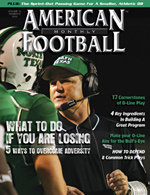Article CategoriesAFM Magazine
|
Strength Report: Practical Nutritional Strategies for the Collegiate Athleteby: Adam FeitHead Sports Performance Coach, Eastern Michigan University © More from this issue As collegiate strength and conditioning coaches, we have learned that there are many more facets of performance that need to be targeted other than simply being strong and in shape. We pride ourselves on faster running times, increased weight room numbers and decreased rates of injuries. However, one of the most overlooked components of athletic performance is the nutritional lifestyle of our athletes. We must remember that performance and recovery are significantly affected by the nutritional choices our athletes make throughout the day. It�s up to us to help our athletes make better choices so that they can train and compete at the highest level. As a former collegiate athlete, I know how difficult it is to properly fuel up for optimal performance; but it can be done. Lack of cooking space, limited meal plans, and overall ....The full article can only be seen by subscribers.
|
|
|||||||
| HOME |
MAGAZINE |
SUBSCRIBE | ONLINE COLUMNISTS | COACHING VIDEOS |
Copyright 2025, AmericanFootballMonthly.com
All Rights Reserved





